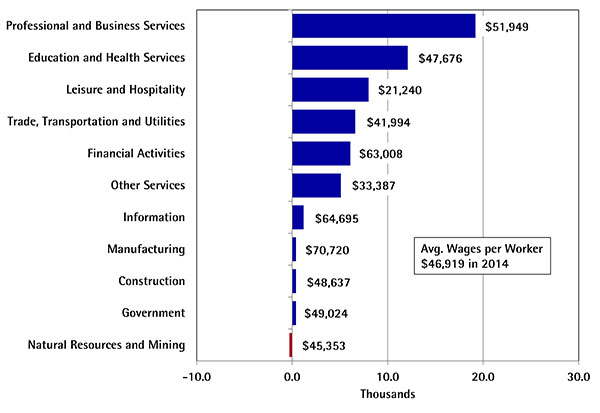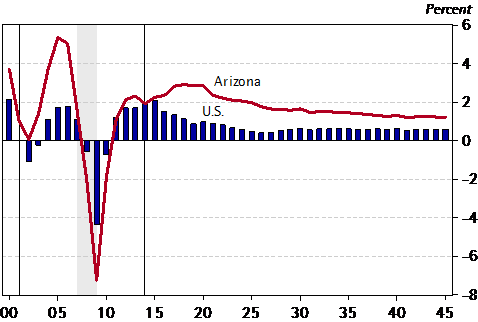By George W. Hammond, Ph.D.
Director and Research Professor, EBRC
Arizona grew much faster than the nation during the 30 years before the Great Recession. The latest 30-year outlook suggests that the state will continue to outpace the nation in terms of job, population, and real income growth. That means the state will have millions more jobs and residents in 2045 that it does today. Further, even after adjusting for inflation, Arizonans can expect to experience a higher level of per capita personal income than ever before. Even though the state will continue to expand in the future, growth rates will gradually decelerate, as Arizona, like the nation, adjusts to the aging of the Baby Boom generation.
Arizona Recent Developments
Arizona job growth softened in the second quarter compared to its rapid first quarter pace. According to our internal benchmark estimates, the state added almost 59,000 jobs in the second quarter, over the year. That translated into 2.3% growth, down from 2.7% in the first quarter, but faster than the national rate in the second quarter of 2.2%.
As Exhibit 1 shows, most sectors added jobs over the year. The largest gains were in professional & business services and education & health services, although leisure & hospitality; trade, transportation& utilities; and financial activities posted solid increases as well. Government jobs were up slightly over the year, reflecting modest gains in the federal government sector. That was the first over-the-year gain in federal employment since late 2010.

Exhibit 1: Most Major Industries in Arizona Added Jobs during the Past Year
Net Change in Jobs from the Second Quarter of 2014 to the Second Quarter of 2015 and Average Annual Wages per Worker in 2014
Job gains in the goods-producing sector were weaker than in the service-providing sector. Natural resources & mining employment declined, which likely reflected falling commodity prices and a rapidly rising dollar. Construction jobs were up slightly, a welcome change from recent losses. Manufacturing jobs were also up a bit, boosted by gains in nondurable industries. Durable manufacturing jobs continued to decline, driven by losses in the computer & electronic products sector and aerospace.
The Phoenix MSA added jobs at a faster pace than the state in the second quarter, with a rate of 3.1% over the year. That was down from the first quarter rate of 3.5%. All major sectors added jobs over the year, with the largest increases in professional & business services; education & health services; and trade, transportation & utilities.
Job growth in the Tucson MSA was positive over the year, hitting 0.5% in the second quarter. As for the Phoenix MSA and the state, that was slower than the 1.1% rate in the first quarter. Job growth was more mixed in Tucson, with gains in professional & business services, leisure & hospitality, education & health services, financial activities, and other services partially offset by losses in government; trade, transportation & utilities; construction; and manufacturing.
The U.S. Census Bureau has released final estimates for Arizona housing permits in 2014. Total permits rose 7.1% in 2014, to 26,997. A 48.8% increase in multi-family activity more than offset the 8.4% decline in single-family permits. Housing permits for the Phoenix MSA rose 8.6% last year, while the Tucson MSA experienced a 6.9% decline.
Arizona Outlook in the Long Run
Arizona is forecast to grow rapidly during the next 30 years, exceeding the national rate of growth for many indicators. However, after the near-term acceleration, growth gradually decelerates, reflecting the demographic aging of the Baby Boom generation. Overall, Arizona’s growth is not forecast to return to the rates experienced during the 30 years before the Great Recession.
The forecast calls for the state to add 1.8 million jobs and 3.8 million residents during the next 30 years, to reach 4.4 million jobs and 10.5 million residents. Overall, job growth averages 1.8% per year during the next 30 years, which is faster than the expected U.S. growth rate of 0.7% per year. However, it is slower than the state’s average rate of job growth during the 30 years prior to the Great Recession. As Exhibit 2 shows, job growth speeds up modestly in the near term, followed by slower, but still positive, gains beginning early in the next decade.
Overall, real per capita personal income is forecast to rise by 1.5% per year during the forecast, which implies a rising standard of living for state residents. However, that is slightly below growth expected for the nation (1.6% per year). This means that the state’s per capita personal income gap with the U.S. (currently at 17.2%) will expand during the forecast period.
Both the Phoenix and Tucson MSAs are expected to expand during the next 30 years. The Phoenix MSA is forecast to add just over 3.0 million residents, to reach a population of 7.5 million by 2045. Phoenix adds 1.5 million jobs from 2015-2045, which translates into an average growth rate of 2.0% per year. Real personal income growth in Phoenix is forecast to average 3.2% per year, which works out to 1.5% per year growth in real per capita personal income.
The Tucson MSA also adds jobs, residents, and real income during the forecast, with population reaching 1.4 million by 2045. Population growth averages 1.2% per year, while job gains come at a slightly more rapid pace of 1.4% per year. That means gradual increases in Tucson’s job-to-population ratio, which rises from 36.2% in 2015 to 39.1% by 2045. Even with the expected improvement, the Tucson MSA ratio remains well below the state and national levels. Browse EBRC’s latest economic forecast data for Arizona, Phoenix-Mesa-Glendale MSA, and Tucson MSA.
Want to know more?
Contact George Hammond about the benefits of becoming a Forecasting Project sponsor!
Photo of businessman on elephant with binoculars courtesy of Shutterstock.






